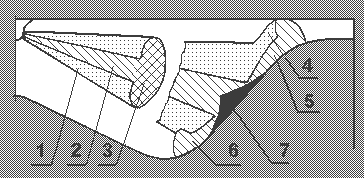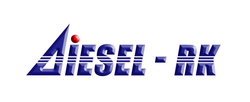Basic stage of diesel spray evolution
On a basic stage of evolution of a diesel
spray each elementary portion of injected fuel moves in an axial core of a spray toward
its top. Reaching the top this portion is superseded on periphery of a jet, is sharply
braked till the complete loss of initial speed and fills in an environment of a spray. The
part of an elementary portion of fuel dissipates in an environment of a spray on the way
to forward front. At approach of a spray to a wall the fuel getting in forward front
gradually passes to the zone of wall surface flow (WSF). The trajectory of a spray and,
accordingly, time and place of its clash with a wall are determined in view of influence
of swirl. The process of interaction of a fuel spray with a wall is rather complicated.
During stacking of forward front of a spray on a wall, conical condensed gas-fuel layer is
formed on it in borders of a stain. The layer formed by crossing of a cone of spray with
the surface of the wall. After fast stacking of spray front on a wall fuel begins to
distribute out of borders of initial stain. The high-speed axial flow of a spray flying up
to a wall condenses the wall surface layer widens its borders. Part of the flow moves
above this layer to its periphery. The form of a wall surface stain and velocity of its
growth in various directions depend on the value of the clash angle of the jet with the
wall. On a fig. 1 a typical film-gramme of the evolution of a spray in the combustion
chamber is shown.

|
Film-gramme is obtained by K.Koptev, V.Gavrilov,
V.Plotnikov (St.-Petersburg ship-building institute). Fuel was injected into the bomb with
the model of the piston. The nozzles size is 7 x 0.4 mm. Speed of shooting is 3700
frame/sec. |
| Fig. 1. |
Contours of fuel spray and diagram of spray tip penetration in conditions
of turbocharged diesel (S/D=300/230, rpm=750, mf= 0.62g) |
Notations:
1. U is a velocity of penetration of spray tip and borders of WSF;
2. l is a distance between sprayer and spray tip and also between sprayer and
borders of WSF;
3. parameters of side borders of WSF;
4. parameters of forward border of WSF;
5. parameters of back border of WSF; ;
6. parameters of free spray tip penetration.
At approach of spray to an inclined wall, small
deviation of tip from the nuzzles axis is observed. The deviation occurs in the part
of a blunt corner of a clash of a spray to a wall. It is caused by formation of a
condensed air flow before spray. The flow front meets with a wall and causes
preliminary turn of spray tip. Having flow along the wall, the spray is distributed
upwards and downwards along its surface. The flow directed upwards on a wall quickly gets
in a clearance above the piston, and in constrained conditions is distributed both on the
top of the piston, and on the surface of the head of the cylinder. The progress of fuel
along a wall is slowed down in comparison with free evolution of a spray because of flow
friction with a wall, and because of loss of the kinetic energy of a spray with drops
reflected from a wall, etc. Moreover, the movement of WSF is influenced by an air
swirl in the combustion chamber. The wall surface flow is non-uniform in structure,
density, temperature. It complicates calculation of fuel evaporation. Therefore, it is
expedient in WSF, as well as in a free spray, to allocate three characteristic zones
with average parameters of heat- and mass-exchange (Fig.2).
Diagram of a diesel spray  |
Notations:
1 - Rare environment of a spray.
2 - Dense axial core of free spray.
3 - Dense forward front.
4 - Rare environment of a wall surface flow (WSF).
5 - Dense core of a WSF on a piston bowl surface.
6 - Forward front of a WSF.
7 - Axial conical core of a WSF
|
Fig. 2. Character zones of diesel spray.
The first zone is an axial conic nucleus on
a wall (7). It is formed at stacking of the front of a spray on a wall. Further, the
structure of this nucleus is continuously updated at the expense of new portions of fuel
flying up to a wall. The second zone is a WSF of fuel extending out of borders of an
initial stain (5). The third zone is a rare environment above the WSF (4), where a part of
fuel braked in forward front of a wall surface flow (6) passes. At distribution of fuel on
a wall extending in all directions the WSF (deformed by a swirl) can cross any
characteristic border dividing the zones with various conditions of evaporation and
burning of fuel. For example, flow can proceed from a lateral inclined surface of piston
bowl to horizontal crown, or can be distributed further: on a surface of the cylinder
liner, etc. Partial crossing of the wall surface flows formed by adjacent sprays is
also possible. In all these cases amount of fuel crossing the border is calculated by
solution of the problem of crossing of characteristic zones.
To RK-model page










|



